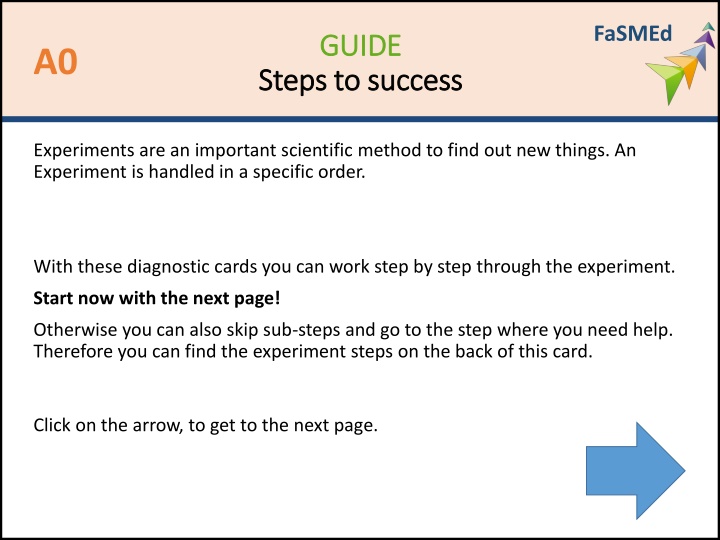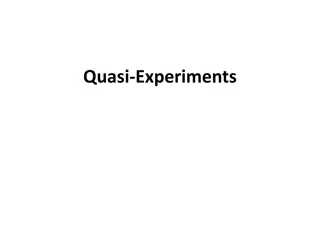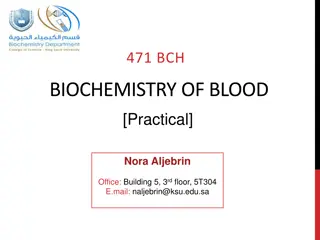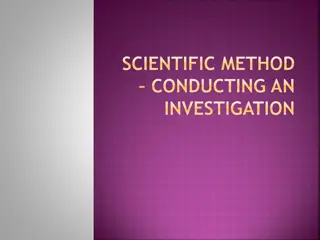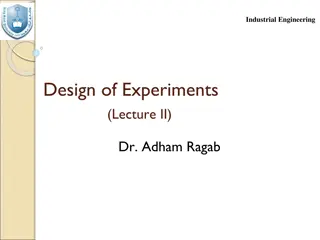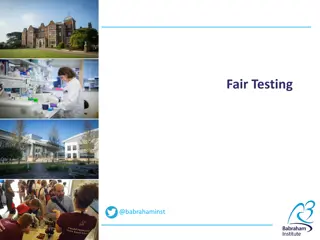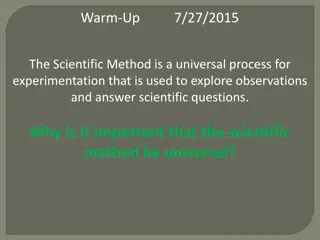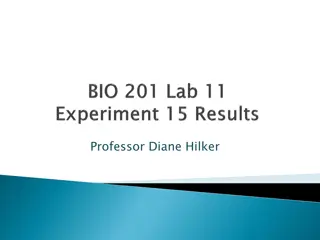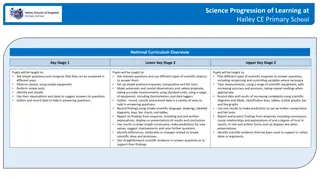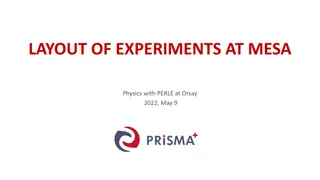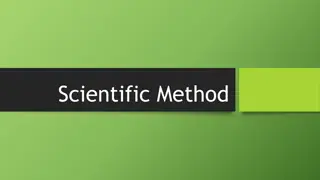Steps to Success: Conducting Scientific Experiments
Scientific experiments play a crucial role in discovering new things. Follow a specific order of steps outlined in the guide to successfully conduct experiments. Begin by understanding biological phenomena, formulating hypotheses, planning, performing experiments, observing results, and drawing conclusions. Utilize the provided diagnostic cards to navigate through each step effectively. Enhance your understanding of biological phenomena and hypothesis formulation with practical exercises and guidance.
Download Presentation

Please find below an Image/Link to download the presentation.
The content on the website is provided AS IS for your information and personal use only. It may not be sold, licensed, or shared on other websites without obtaining consent from the author.If you encounter any issues during the download, it is possible that the publisher has removed the file from their server.
You are allowed to download the files provided on this website for personal or commercial use, subject to the condition that they are used lawfully. All files are the property of their respective owners.
The content on the website is provided AS IS for your information and personal use only. It may not be sold, licensed, or shared on other websites without obtaining consent from the author.
E N D
Presentation Transcript
FaSMEd GUIDE GUIDE A0 Steps Steps to to success success Experiments are an important scientific method to find out new things. An Experiment is handled in a specific order. With these diagnostic cards you can work step by step through the experiment. Start now with the next page! Otherwise you can also skip sub-steps and go to the step where you need help. Therefore you can find the experiment steps on the back of this card. Click on the arrow, to get to the next page.
FaSMEd GUIDE GUIDE A0 Steps Steps to to success success Click on the sub-step, where you want to start Where do you want to start? 1. Biological phenomenon 1. Biological phenomenon 2. Hypothesis 3. Planning If you click on the Logo , you get back you this page any time. 2. Hypothesis 3. Planning 4. Performing and observing 4. Performing and observing 5. Results 5. Results
FaSMEd Phenomenon Phenomenon A1 What is a biological phenomenon? What is a biological phenomenon? A biological phenomenon is a visible phenomenon or a process from nature. In this lesson we want to investigate the phenomenon of the newspaper article in detail and design an appropriate experiment. After the experiment, you'll have made some observations that will help you to explain the phenomenon. Read over the newspaper article again and underline the important information. Pay attention to the function of the toothpaste when brushing.
FaSMEd A1 Solution Solution In the newspaper article you can find lots of information. They all describe a common biological phenomenon that occurs every day in your everyday life. Follow the instructions! How did you proceed? I do not know how to formulate the biological phenomenon.(A1.1) I do not know how to formulate the biological phenomenon.(A1.1) I have formulated a biological phenomenon.(A2) I have formulated a biological phenomenon.(A2) Mir fehlen wichtige Informationen, um ein Ph nomen zu erkennen. (A1.2) Mir fehlen wichtige Informationen, um ein Ph nomen zu erkennen. (A1.2)
FaSMEd EXPERIMENT EXPERIMENT Can I propose a hypothesis? Can I propose a hypothesis? A2 Now that you've discovered the biological phenomenon, it is important that you formulate a hypothesis. This hypothesis is the basis for your experiment. Propose a hypothesis for the stated problem.
FaSMEd A2 Solution Solution You need to have a little practice in order to establish a clear hypothesis. The questions below will help here. Follow the instructions! Any questions? I could set up a phenomenon. How should I use it to create a hypothesis? (A2.1) I could set up a phenomenon. How should I use it to create a hypothesis? (A2.1) What is a hypothesis? (A2.2) What is a hypothesis? (A2.2) What is the structure of a hypothesis? (A2.3) What is the structure of a hypothesis? (A2.3) I could set up a scientific hypothesis.(A3) I could set up a scientific hypothesis.(A3)
FaSMEd EXPERIMENT EXPERIMENT What What must must be A3 be planned planned? ? When the experiment starts, you have no time to think about the individual experimental steps. Therefore, you should have planned and provided everything before the experiment. What must be considered and planned before experimenting everything?
FaSMEd A3 Solution Solution Bevor es nun mit dem Experiment losgeht solltest du berpr fen, ob du alles vorbereitet und beachtet hast. Folge dn Anweisungen. Have you noticed ALL of the following? No? Continue here! I have all the materials ready: the PROTECTION of hands and eyes, the object under examination, a suitable container and the necessary chemicals. A3.1) No? Continue here! No? Continue here! I have my experiment planned so that I only need one No? Continue here! examination subject. (A3.2) No? Continue here! I let other factors that may affect the experiment out or keep No? Continue here! them constant. (A3.3) No? Continue here! I have noted the planned steps and the duration of the No? Continue here! experiment clearly.. (A3.4) Yes? Continue here! Yes? Continue here! I ve noticed ALL four (obove) points.. (A4)
EXPERIMENT EXPERIMENT FaSMEd A4 Have I observed everything and listed my Have I observed everything and listed my results? results? Orientate yourself while performing the experiment on your created instruction manual. Since you have two test preparations, you have to pay particular attention to the differences in the implementation! Perform the experiment. Do not forget to write down your observations during or directly after the execution!
FaSMEd A4 Solution Solution It wouldn t be good to forget the test results. Even small differences in the observations have major implications for the subsequent interpretation. Therefore write down your observations as accurately as possible. How did you proceed? For my notes more background knowledge is missing (A4.2). For my notes more background knowledge is missing (A4.2). My experimental approaches have shown no major differences(A4.1). My experimental approaches have shown no major differences(A4.1). I could record my various observations (A5). I could record my various observations (A5).
FaSMEd RESULTS RESULTS A5 Can I confirm the hypothesis? Can I confirm the hypothesis? Now compare your observations with your created hypothesis from the beginning. It is not bad if the hypothesis turns out to be false. Can you confirm your hypothesis for the experiment? If not, can you set up a new hypothesis?
FaSMEd A5 Solution Solution After your experiment you should evaluate whether your hypothesis has proved to be true. Follow the instructions! How did you proceed? I see no connection to my hypothesis(A5.1). I see no connection to my hypothesis(A5.1). My hypothesis was confirmed (A6). My hypothesis was confirmed (A6). I had to reject my hypothesis and could set a new one (A6). I had to reject my hypothesis and could set a new one (A6).
FaSMEd RESULTS RESULTS conclude from A6 What What can can you you conclude from the the experiment experiment? ? You are now almost done! With the results of your experiment, you can now try to explain the biological phenomenon. Do you see similarities between experiment and phenomenon? Explain the biological phenomenon based on your observations from the experiment.
FaSMEd A6 Solution Solution Could you explain the phenomenon with the experiment? No: I can t explain the experimental observations (A6.1). No: I can t explain the experimental observations (A6.1). No: I see no connection between the egg and the human teeth (A6.2). No: I see no connection between the egg and the human teeth (A6.2). Yes: I could explain the biological phenomenon (A7). Yes: I could explain the biological phenomenon (A7).
FaSMEd GOAL GOAL A7 You did it! Isn't it amazing that you can see the effects of toothpaste on the egg so clearly? In addition to the attack of the outer layer of the teeth by acidic foods, leftovers in the mouth promote the growth of bacteria, convert the sugar to acid and endanger your teeth even further. Therefore, unfortunately, it is not enough to rinse out your mouth with toothpaste or mouthwash. The toothbrush distributes the toothpaste in every little corner and removes bacterial cultures mechanically on the teeth.
FaSMEd A1.1 Good Good to to know know A biological phenomenon is a visible phenomenon or a process in nature. Researchers want to make statements not only about their own experiment, but transfer the observations to an observed phenomenon. Try to detect the key idea in the description of the phenomenon. Example: Researchers think that young people can perceive higher sounds than old people. Then the biological phenomenon is: "Young people hear higher sounds better than old people." Then they do different experiments for hearing. So they try to explain the phenomenon: Why do young people hear better?
FaSMEd A1.2 Good Good to to know know Important information from the text are for example: - Acids attack the teeth. - Teeth consist of compounds which are also in the shell of chick eggs. - Toothpaste forms a protective coating on the teeth and strengthens the outer layer of the teeth. All this information are useful for the description of a biological phenomenon. However, the phenomenon should be no longer than one sentence. Try to detect the key idea in the description of the phenomenon.
FaSMEd A2.1 Good Good to to know know A biological phenomenon may be very extensive. You can t really investigate all possible influences or ideas in one experiment. Therefore, it is important that you limit the experiment to one factor and formulate in your hypothesis clearly what you want to check. The Example: biological phenomenon: "The sunflower seeds do not germinate" is very general. In an experiment, you can now examine a variable. For example, you can set up the concrete hypothesis: "Sunflower seeds need water to germinate. Instead of the variable water you could also check if other things (like sunlight) are necessary. It is important that you always choose only one variable.
FaSMEd A2.2 Good Good to to know know A hypothesis is an assumption which you haven t tested with an experiment. Only after your experiment, you can either confirm (if everything happened like you described) or correct your hypothesis. Example: You examine the phenomenon "The tulips close its flowers at night." In your experiment you examine the relationship between the two factors "sunlight" and "opening of the flower." Then the hypothesis is: "If the tulips get no sunlight, they close the blossom".
FaSMEd A2.3 Good Good to to know know A hypothesis is an assumption that you haven t tested yet. For a scientific hypothesis, it is important that you examine the relationship between two variables. Often the hypothesis is generally written like that: - If factor 1 is present, then something happens with factor 2. - If factor 1 is not present, then something else happens with factor 2. Examples: When the plant gets water, it can grow. When the plant gets no sunlight, it can t grow.
FaSMEd A3.1 Good Good to to know know What materials do I need? material function Beaker Accommodate the egg Protective gloves, protective glasses Used for protection when working with acid PaperTowels Helps wiping the toothpaste Spoon Helps dip the egg into the beaker Vinegar Serves as acid Fluoride toothpaste Forms a protective layer that protects against acid attacks Water To rinse the toothpaste Hard-Boiled Egg The calcium layer (lime) eggshell is similar to human enamel
FaSMEd A3.2 Good Good to to know know To save material, you often try to test several experimental approaches simultaneously. This also saves time in the preparation and implementation. Example: You examine on a piece of turf the effect of sunlight on the leaf color. You examine the difference: with sunlight / without sunlight. In the experiment you can cover one half of the grass land with cardboard. The other half is not covered. Can you investigate in your experiment both approaches simultaneously on one object?
FaSMEd A3.3 Good Good to to know know To compare your experiment with others, you have to perform all experiments in the same manner. Sometimes external factors can influence your experiment and lead to a different result. Variables that influence your experiment must therefore kept constant. Write them down in your notes! Important factors include: Temperature, sunlight, weight, size, ... Example: In a snail race you measure the time snail a worm reaches the target. To ensure that all snails have the same conditions, the length of the course should be the same for all.
FaSMEd A3.4 Good Good to to know know When the experiment starts, you have to act fast! You have no more time to think about the next step. Therefore you should have noted what steps must be taken and in what order. Is in one step the time / duration important? Write them down. This is to compare the results with others. Your test procedure should not take longer than 15 minutes. Example: Do you prefer your boiled egg with solid or liquid egg yolk? If the egg is boiled a few seconds longer in water the egg yolk gets hard.
FaSMEd A4.1 Good Good to to know know In this experiment, you have set up two experimental approaches to verify the effects of the toothpaste. One side of the chicken egg should have been brushed with toothpaste. The other side was not coated. You can make the following observations: Egg-side with toothpaste After dipping in the vinegar acid you can make no observations. (Also possible: You can see a few bubbles on the treated side.) Egg-side without toothpaste You can see many small bubbles on the untreated side after insertion into the vinegar acid. Compare your observations with the requirements. Have you also tried to wipe the toothpaste and lay the egg in the vinegar again? What can you observe now?
FaSMEd A4.2 Good Good to to know know Write your observations as precisely as possible! In this part you shouldn t write down explanations or suppositions. The observation only includes happenings that you could see. Only in the evaluation you should explain your observations. Example: When you open a bottle of water with gas, you see many small bubbles rising to the top. In your observation you are not allowed to write that these bubbles are made of carbon dioxide!
FaSMEd A5.1 Good Good to to know know Look at your hypothesis again. You've written down a presumption of the relationship between two factors. These two factors can also be found in your experiment. - You have varied factor 1. He is either present or absent. - Thereupon effects have shown in factor 2, which you can see. Note: The effects have been found in your experiment as bubbles. Perhaps you have formulated other effects in your hypothesis. Next, we consider why the bubbles formed.
FaSMEd A6.1 Good Good to to know know The following information can be found on the worksheet: Food that contains a lot of acid can cause significant damage to the teeth. At first the enamel is attacked, the hard protective outer layer of the teeth. This enamel contains Calcium compounds which are also in the shell of chicken eggs. Fluoride toothpastes also help to strengthen the outer layer of the teeth by creating a protective layer which protects the teeth against acid attacks. You've examined two different experimental approaches: With / without toothpaste. Both approaches have been placed in a glass with (vinegar) acid. Gas has formed, which is visible in the form of bubbles. What could have led to the formation of gas? Why are on the surface with toothpaste fewer bubbles?
FaSMEd A6.2 Good Good to to know know The following information can be found on the worksheet: Food that contains a lot of acid can cause significant damage to the teeth. At first the enamel is attacked, the hard protective outer layer of the teeth. This enamel contains Calcium compounds which are also in the shell of chicken eggs. Fluoride toothpastes also help to strengthen the outer layer of the teeth by creating a protective layer which protects the teeth against acid attacks. You have used chicken eggs instead of the teeth in your experiment. Explain! Do you think that you would make the same experimental observations, if you could use real teeth for your experiment?
